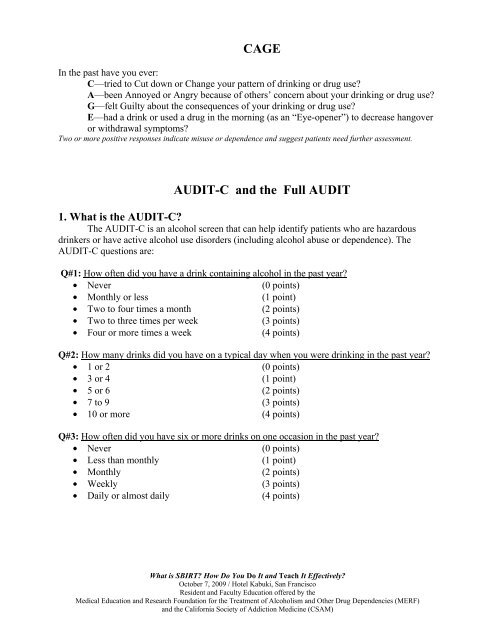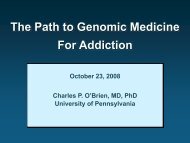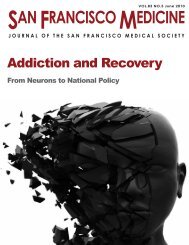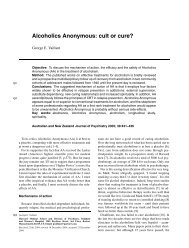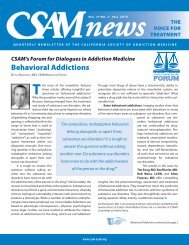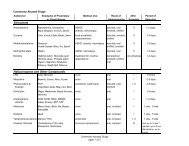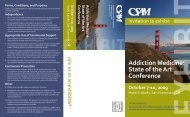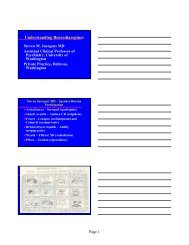CAGE, AUDIT, DAST - California Society of Addiction Medicine
CAGE, AUDIT, DAST - California Society of Addiction Medicine
CAGE, AUDIT, DAST - California Society of Addiction Medicine
You also want an ePaper? Increase the reach of your titles
YUMPU automatically turns print PDFs into web optimized ePapers that Google loves.
<strong>CAGE</strong><br />
In the past have you ever:<br />
C—tried to Cut down or Change your pattern <strong>of</strong> drinking or drug use?<br />
A—been Annoyed or Angry because <strong>of</strong> others’ concern about your drinking or drug use?<br />
G—felt Guilty about the consequences <strong>of</strong> your drinking or drug use?<br />
E—had a drink or used a drug in the morning (as an “Eye-opener”) to decrease hangover<br />
or withdrawal symptoms?<br />
Two or more positive responses indicate misuse or dependence and suggest patients need further assessment.<br />
<strong>AUDIT</strong>-C and the Full <strong>AUDIT</strong><br />
1. What is the <strong>AUDIT</strong>-C?<br />
The <strong>AUDIT</strong>-C is an alcohol screen that can help identify patients who are hazardous<br />
drinkers or have active alcohol use disorders (including alcohol abuse or dependence). The<br />
<strong>AUDIT</strong>-C questions are:<br />
Q#1: How <strong>of</strong>ten did you have a drink containing alcohol in the past year?<br />
• Never (0 points)<br />
• Monthly or less (1 point)<br />
• Two to four times a month (2 points)<br />
• Two to three times per week (3 points)<br />
• Four or more times a week (4 points)<br />
Q#2: How many drinks did you have on a typical day when you were drinking in the past year?<br />
• 1 or 2 (0 points)<br />
• 3 or 4 (1 point)<br />
• 5 or 6 (2 points)<br />
• 7 to 9 (3 points)<br />
• 10 or more (4 points)<br />
Q#3: How <strong>of</strong>ten did you have six or more drinks on one occasion in the past year?<br />
• Never (0 points)<br />
• Less than monthly (1 point)<br />
• Monthly (2 points)<br />
• Weekly (3 points)<br />
• Daily or almost daily (4 points)<br />
What is SBIRT? How Do You Do It and Teach It Effectively?<br />
October 7, 2009 / Hotel Kabuki, San Francisco<br />
Resident and Faculty Education <strong>of</strong>fered by the<br />
Medical Education and Research Foundation for the Treatment <strong>of</strong> Alcoholism and Other Drug Dependencies (MERF)<br />
and the <strong>California</strong> <strong>Society</strong> <strong>of</strong> <strong>Addiction</strong> <strong>Medicine</strong> (CSAM)
The <strong>AUDIT</strong>-C is scored on a scale <strong>of</strong> 0-12 (scores <strong>of</strong> 0 reflect no alcohol use). In men, a score <strong>of</strong> 4 or<br />
more is considered positive; in women, a score <strong>of</strong> 3 or more is considered positive. Generally, the higher<br />
the <strong>AUDIT</strong>-C score, the more likely it is that the patient’s drinking is affecting his/her health and safety.<br />
2. What does a positive <strong>AUDIT</strong>-C score mean?<br />
A positive score means the patient has a higher likelihood for at risk drinking or active alcohol<br />
abuse or dependence.<br />
3. Why don’t we use the <strong>CAGE</strong> anymore?<br />
The <strong>CAGE</strong> fails to identify many patients with at risk drinking who are not alcohol dependent.[2]<br />
It is important to identify at risk drinkers because they may also benefit from advice from primary care<br />
providers about their drinking.[3]<br />
4. What is at risk drinking?<br />
At risk drinking is drinking above recommended limits that increases a patient’s risk <strong>of</strong> injury<br />
and/or medical problems. Most patients who report at risk drinking are not alcohol dependent. However,<br />
there are so many <strong>of</strong> these non-dependent, at risk drinkers that they account for most <strong>of</strong> the morbidity and<br />
mortality that is attributed to drinking.[4]<br />
5. If a patient screens positive on the <strong>AUDIT</strong>-C, is it likely they are alcohol<br />
dependent?<br />
Most patients who screen positive on the <strong>AUDIT</strong>-C will be at risk drinkers who are not alcohol<br />
dependent. By using both the <strong>AUDIT</strong>-C score, and the patient’s history <strong>of</strong> alcohol treatment, it is<br />
possible to identify those most likely to be alcohol dependent. For patients who have never been in<br />
alcohol treatment (or attended AA), scores > 8 are associated with relatively high rates <strong>of</strong> dependence.<br />
Patients who have had past alcohol treatment are at high risk <strong>of</strong> dependence with any positive <strong>AUDIT</strong>-C<br />
score.<br />
6. What is appropriate follow-up for a positive <strong>AUDIT</strong>-C screen?<br />
See recommendations under Interpretation/Follow-up <strong>of</strong> <strong>AUDIT</strong>-C Scores.<br />
7. Does everyone who screens positive on the <strong>AUDIT</strong>-C need a full assessment<br />
or referral?<br />
Not everyone needs a full assessment or referral. Since the <strong>AUDIT</strong>-C reflects severity, the raw<br />
score can be used to assess the likelihood that the patient has alcohol dependence. For patients with<br />
<strong>AUDIT</strong>-C scores 4-7 and no prior alcohol treatment, the provider should <strong>of</strong>fer a brief intervention as<br />
follows:<br />
1). Express concern about the patient’s drinking, if drinking above recommended limits;<br />
2) Provide feedback linking the patient’s drinking to his/her health concerns, noting that<br />
patient is drinking above recommended limits, and<br />
3) Offer explicit advice to stay below recommended limits<br />
Patients with more severe problems due to drinking who are do not to accept referral can also be <strong>of</strong>fered<br />
brief intervention. If providers want more information on specific symptoms due to drinking, questions<br />
#4-10 <strong>of</strong> the full <strong>AUDIT</strong> can be used as a brief assessment or patients can be referred to a mental health<br />
specialist.<br />
What is SBIRT? How Do You Do It and Teach It Effectively?<br />
October 7, 2009 / Hotel Kabuki, San Francisco<br />
Resident and Faculty Education <strong>of</strong>fered by the<br />
Medical Education and Research Foundation for the Treatment <strong>of</strong> Alcoholism and Other Drug Dependencies (MERF)<br />
and the <strong>California</strong> <strong>Society</strong> <strong>of</strong> <strong>Addiction</strong> <strong>Medicine</strong> (CSAM)
8. Why do patients who have only one drink a day screen positive on the<br />
<strong>AUDIT</strong>-C?<br />
The optimal screening thresholds are based on studies that used in-depth interviews to<br />
assess the patient’s drinking and problems due to drinking. These studies found that scores <strong>of</strong> 4<br />
for men (3 for women) were optimal for identifying those with hazardous drinking or active<br />
alcohol use disorders.[5, 6] However, like all screening tests, the <strong>AUDIT</strong>-C does give some<br />
false positives.<br />
A score <strong>of</strong> 4 points for men (3 for women) is used as the threshold for potentially hazardous<br />
drinking. However, when the points are all from question #1 alone (questions #2 & #3 score are<br />
zero), it can be assumed that the patient is drinking below recommended limits. In this situation,<br />
we recommend that the provider review the patient’s alcohol intake over the past few months to<br />
confirm accuracy (e.g. “Has this been your consistent pattern over the past 2-3 months?”),<br />
review the problem list to ensure there are no medical contraindications due to drinking (e.g.<br />
hepatitis C, prior alcohol treatment), and advise the patient to stay below recommended limits.<br />
Recommended limits:<br />
Men: No more than 14 drinks a week, 4 drinks per occasion<br />
Women: No more than 7 drinks a week, 3 drinks per occasion<br />
9. Will the <strong>AUDIT</strong>-C miss alcohol dependence?<br />
In validation studies that compared the <strong>AUDIT</strong>-C to in-depth interviews, the <strong>AUDIT</strong>-C<br />
was as good as the <strong>CAGE</strong> Questionnaire for identifying male patients with active alcohol abuse<br />
or dependence.[2, 5] It was also an effective screening test for active alcohol abuse or<br />
dependence in women [6] and more effective than the TWEAK (an adaptation <strong>of</strong> the <strong>CAGE</strong> for<br />
women). [7]<br />
10. Why is the <strong>AUDIT</strong>-C cut-<strong>of</strong>f higher for men than women?<br />
The recommended cut-<strong>of</strong>f for women is based on a study <strong>of</strong> female VA patients, which<br />
used in-depth interviews to assess their drinking patterns and problems due to drinking.[6]<br />
Women develop problems due to drinking at lower levels <strong>of</strong> alcohol consumption than men.<br />
This reflects their lower total body water as well as possible differences in metabolism. Alcohol<br />
use is also more stigmatized for women compared to men, so women may be more likely to<br />
under-report their drinking.<br />
Recommended Limits: [1]<br />
PREVENTIVE ADVICE<br />
Men: No more than 14 drinks a week, and 4 drinks Advise on any patient single to occasion stay below<br />
Women: No more than 7 drinks a week, and 3 drinks recommended on any single limits occasion<br />
What is SBIRT? How Do You Do It and Teach It Effectively?<br />
October 7, 2009 / Hotel Kabuki, San Francisco<br />
Resident and Faculty Education <strong>of</strong>fered by the<br />
Medical Education and Research Foundation for the Treatment <strong>of</strong> Alcoholism and Other Drug Dependencies (MERF)<br />
and the <strong>California</strong> <strong>Society</strong> <strong>of</strong> <strong>Addiction</strong> <strong>Medicine</strong> (CSAM)
The FULL <strong>AUDIT</strong> -- <strong>AUDIT</strong> QUESTIONS #4-10:<br />
Q#4: How <strong>of</strong>ten during the last year have you found that you were not able to stop drinking once you had<br />
started?<br />
• Never (0 points)<br />
• Less than monthly (1 point)<br />
• Monthly (2 points)<br />
• Weekly (3 points)<br />
• Daily or almost daily (4 points)<br />
Q#5: How <strong>of</strong>ten during the last year have you failed to do what was normally expected from you because<br />
<strong>of</strong> drinking?<br />
• Never (0 points)<br />
• Less than monthly (1 point)<br />
• Monthly (2 points)<br />
• Weekly (3 points)<br />
• Daily or almost daily (4 points)<br />
Q#6: How <strong>of</strong>ten during the last year have you needed a first drink in the morning to get yourself going<br />
after a heavy drinking session?<br />
• Never (0 points)<br />
• Less than monthly (1 point)<br />
• Monthly (2 points)<br />
• Weekly (3 points)<br />
• Daily or almost daily (4 points)<br />
Q#7: How <strong>of</strong>ten during the last year have you had a feeling <strong>of</strong> guilt or remorse after drinking?<br />
• Never (0 points)<br />
• Less than monthly (1 point)<br />
• Monthly (2 points)<br />
• Weekly (3 points)<br />
• Daily or almost daily (4 points)<br />
Q#8: How <strong>of</strong>ten during the last year have you been unable to remember what happened the night before<br />
because you had been drinking?<br />
• Never (0 points)<br />
• Less than monthly (1 point)<br />
• Monthly (2 points)<br />
• Weekly (3 points)<br />
• Daily or almost daily (4 points)<br />
Q#9: Have you, or has someone else, been injured as a result <strong>of</strong> your drinking?<br />
• No (0 points)<br />
• Yes, but not in the last year (2 points)<br />
• Yes, during the last year (4 points)<br />
Q#10: Has a relative or friend, or a doctor or other health worker, been concerned about your drinking or<br />
suggested you cut down?<br />
• No (0 points)<br />
• Yes, but not in the last year (2 points)<br />
• Yes, during the last year (4 points)<br />
What is SBIRT? How Do You Do It and Teach It Effectively?<br />
October 7, 2009 / Hotel Kabuki, San Francisco<br />
Resident and Faculty Education <strong>of</strong>fered by the<br />
Medical Education and Research Foundation for the Treatment <strong>of</strong> Alcoholism and Other Drug Dependencies (MERF)<br />
and the <strong>California</strong> <strong>Society</strong> <strong>of</strong> <strong>Addiction</strong> <strong>Medicine</strong> (CSAM)
Substance Abuse Screening Instrument (O4/05)<br />
The Drug Abuse Screening Test (<strong>DAST</strong>) was developed in 1982 and is still an excellent screening tool. It is a 28-item self-report<br />
scale that consists <strong>of</strong> items that parallel those <strong>of</strong> the Michigan Alcoholism Screening Test (MAST). The <strong>DAST</strong> has “exhibited valid<br />
psychometric properties” and has been found to be “a sensitive screening instrument for the abuse <strong>of</strong> drugs other than alcohol.<br />
The Drug Abuse Screening Test (<strong>DAST</strong>)<br />
Directions: The following questions concern information about your involvement with drugs. Drug abuse refers to (1) the<br />
use <strong>of</strong> prescribed or “over-the-counter” drugs in excess <strong>of</strong> the directions, and (2) any non-medical use <strong>of</strong> drugs. Consider<br />
the past year (12 months) and carefully read each statement. Then decide whether your answer is YES or NO and check<br />
the appropriate space. Please be sure to answer every question.<br />
YES NO<br />
1. Have you used drugs other than those required for medical reasons? ___ ___<br />
2. Have you abused prescription drugs? ___ ___<br />
3. Do you abuse more than one drug at a time? ___ ___<br />
4. Can you get through the week without using drugs<br />
(other than those required for medical reasons)? ___ ___<br />
5. Are you always able to stop using drugs when you want to? ___ ___<br />
6. Do you abuse drugs on a continuous basis? ___ ___<br />
7. Do you try to limit your drug use to certain situations? ___ ___<br />
8. Have you had “blackouts” or “flashbacks” as a result <strong>of</strong> drug use? ___ ___<br />
9. Do you ever feel bad about your drug abuse? ___ ___<br />
10. Does your spouse (or parents) ever complain about your involvement with<br />
drugs? ___ ___<br />
11. Do your friends or relatives know or suspect you abuse drugs? ___ ___<br />
12. Has drug abuse ever created problems between you and your spouse? ___ ___<br />
13. Has any family member ever sought help for problems related to your drug<br />
use? ___ ___<br />
14. Have you ever lost friends because <strong>of</strong> your use <strong>of</strong> drugs? ___ ___<br />
15. Have you ever neglected your family or missed work because <strong>of</strong> your use <strong>of</strong><br />
drugs? ___ ___<br />
16. Have you ever been in trouble at work because <strong>of</strong> drug abuse? ___ ___<br />
17. Have you ever lost a job because <strong>of</strong> drug abuse? ___ ___<br />
18. Have you gotten into fights when under the influence <strong>of</strong> drugs? ___ ___<br />
19. Have you ever been arrested because <strong>of</strong> unusual behavior while under the<br />
influence <strong>of</strong> drugs? ___ ___<br />
20. Have you ever been arrested for driving while under the influence <strong>of</strong> drugs? ___ ___<br />
21. Have you engaged in illegal activities in order to obtain drug? ___ ___<br />
22. Have you ever been arrested for possession <strong>of</strong> illegal drugs? ___ ___<br />
23. Have you ever experienced withdrawal symptoms as a result <strong>of</strong> heavy<br />
drug intake? ___ ___<br />
24. Have you had medical problems as a result <strong>of</strong> your drug use<br />
(e.g., memory loss, hepatitis, convulsions, bleeding, etc.)? ___ ___<br />
25. Have you ever gone to anyone for help for a drug problem? ___ ___<br />
26. Have you ever been in a hospital for medical problems related to<br />
your drug use? ___ ___<br />
27. Have you ever been involved in a treatment program specifically<br />
related to drug use? ___ ___<br />
28. Have you been treated as an outpatient for problems related to drug abuse? ___ ___<br />
Scoring and interpretation: A score <strong>of</strong> “1” is given for each YES response, except for items 4,5, and 7, for which a NO<br />
response is given a score <strong>of</strong> “1.” Based on data from a heterogeneous psychiatric patient population, cut<strong>of</strong>f scores <strong>of</strong> 6<br />
through 11 are considered to be optimal for screening for substance use disorders. Using a cut<strong>of</strong>f score <strong>of</strong> 6 has been found to<br />
provide excellent sensitivity for identifying patients with substance use disorders as well as satisfactory specificity (i.e.,<br />
identification <strong>of</strong> patients who do not have substance use disorders). Using a cut<strong>of</strong>f score <strong>of</strong>
References Cited:<br />
1. National Institute on Alcohol Abuse and Alcoholism, U.D.o.H.a.H.s. and National<br />
Institute <strong>of</strong> Health, Helping patients with alcohol problems: A practitioner's guide.<br />
2003.<br />
2. Bradley KA, et al., Screening for problem drinking: comparison <strong>of</strong> <strong>CAGE</strong> and<br />
<strong>AUDIT</strong>. J Gen Intern Med, 1998. 13(6): p. 379-388.<br />
3. Fleming MF, et al., Brief physician advice for problem alcohol drinkers: a randomized<br />
controlled trial in community-based primary care practices. JAMA, 1997. 277(13): p.<br />
1039-1045.<br />
4. Institute <strong>of</strong> <strong>Medicine</strong>, Broadening the Base <strong>of</strong> Treatment for Alcohol Problems: A<br />
Report <strong>of</strong> the Committee for the Study <strong>of</strong> Treatment and Rehabilitation for Alcoholism.<br />
1990, Washington DC: National Academy Press. 1-629.<br />
5. Bush K, et al., The <strong>AUDIT</strong> alcohol consumption questions (<strong>AUDIT</strong>-C): an effective<br />
brief screening test for problem drinking. Arch Intern Med, 1998. 158: p. 1789-1795.<br />
6. Bradley KA, et al., Two brief alcohol screening tests from the Alcohol Use Disorders<br />
Identification Test (<strong>AUDIT</strong>): validation in a female VA patient population. Arch<br />
Intern Med, 2003. 163: p. 821-839.<br />
7. Bush KR, et al., The TWEAK is weak for alcohol screening among female VA<br />
outpatients. Alcoholism: Clinical and Experimental Research, In press 2003.<br />
What is SBIRT? How Do You Do It and Teach It Effectively?<br />
October 7, 2009 / Hotel Kabuki, San Francisco<br />
Resident and Faculty Education <strong>of</strong>fered by the<br />
Medical Education and Research Foundation for the Treatment <strong>of</strong> Alcoholism and Other Drug Dependencies (MERF)<br />
and the <strong>California</strong> <strong>Society</strong> <strong>of</strong> <strong>Addiction</strong> <strong>Medicine</strong> (CSAM)


